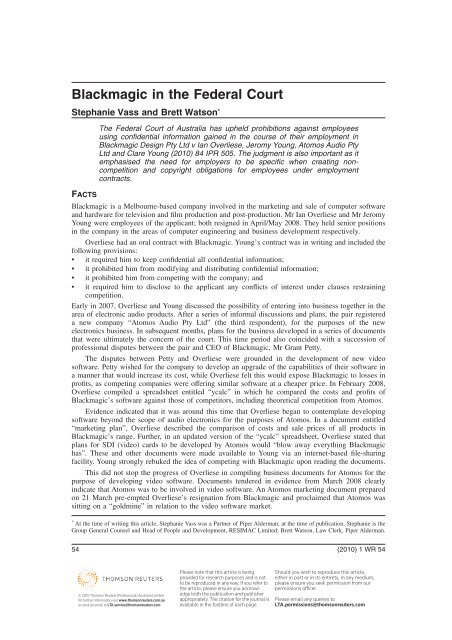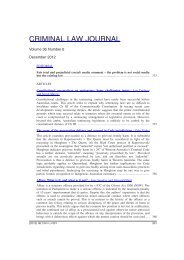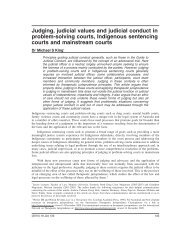Blackmagic in the Federal Court - Thomson Reuters
Blackmagic in the Federal Court - Thomson Reuters
Blackmagic in the Federal Court - Thomson Reuters
Create successful ePaper yourself
Turn your PDF publications into a flip-book with our unique Google optimized e-Paper software.
<strong>Blackmagic</strong> <strong>in</strong> <strong>the</strong> <strong>Federal</strong> <strong>Court</strong><br />
Stephanie Vass and Brett Watson *<br />
FACTS<br />
The <strong>Federal</strong> <strong>Court</strong> of Australia has upheld prohibitions aga<strong>in</strong>st employees<br />
us<strong>in</strong>g confidential <strong>in</strong>formation ga<strong>in</strong>ed <strong>in</strong> <strong>the</strong> course of <strong>the</strong>ir employment <strong>in</strong><br />
<strong>Blackmagic</strong> Design Pty Ltd v Ian Overliese, Jeromy Young, Atomos Audio Pty<br />
Ltd and Clare Young (2010) 84 IPR 505. The judgment is also important as it<br />
emphasised <strong>the</strong> need for employers to be specific when creat<strong>in</strong>g noncompetition<br />
and copyright obligations for employees under employment<br />
contracts.<br />
<strong>Blackmagic</strong> is a Melbourne-based company <strong>in</strong>volved <strong>in</strong> <strong>the</strong> market<strong>in</strong>g and sale of computer software<br />
and hardware for television and film production and post-production. Mr Ian Overliese and Mr Jeromy<br />
Young were employees of <strong>the</strong> applicant; both resigned <strong>in</strong> April/May 2008. They held senior positions<br />
<strong>in</strong> <strong>the</strong> company <strong>in</strong> <strong>the</strong> areas of computer eng<strong>in</strong>eer<strong>in</strong>g and bus<strong>in</strong>ess development respectively.<br />
Overliese had an oral contract with <strong>Blackmagic</strong>. Young’s contract was <strong>in</strong> writ<strong>in</strong>g and <strong>in</strong>cluded <strong>the</strong><br />
follow<strong>in</strong>g provisions:<br />
• it required him to keep confidential all confidential <strong>in</strong>formation;<br />
• it prohibited him from modify<strong>in</strong>g and distribut<strong>in</strong>g confidential <strong>in</strong>formation;<br />
• it prohibited him from compet<strong>in</strong>g with <strong>the</strong> company; and<br />
• it required him to disclose to <strong>the</strong> applicant any conflicts of <strong>in</strong>terest under clauses restra<strong>in</strong><strong>in</strong>g<br />
competition.<br />
Early <strong>in</strong> 2007, Overliese and Young discussed <strong>the</strong> possibility of enter<strong>in</strong>g <strong>in</strong>to bus<strong>in</strong>ess toge<strong>the</strong>r <strong>in</strong> <strong>the</strong><br />
area of electronic audio products. After a series of <strong>in</strong>formal discussions and plans, <strong>the</strong> pair registered<br />
a new company “Atomos Audio Pty Ltd” (<strong>the</strong> third respondent), for <strong>the</strong> purposes of <strong>the</strong> new<br />
electronics bus<strong>in</strong>ess. In subsequent months, plans for <strong>the</strong> bus<strong>in</strong>ess developed <strong>in</strong> a series of documents<br />
that were ultimately <strong>the</strong> concern of <strong>the</strong> court. This time period also co<strong>in</strong>cided with a succession of<br />
professional disputes between <strong>the</strong> pair and CEO of <strong>Blackmagic</strong>, Mr Grant Petty.<br />
The disputes between Petty and Overliese were grounded <strong>in</strong> <strong>the</strong> development of new video<br />
software. Petty wished for <strong>the</strong> company to develop an upgrade of <strong>the</strong> capabilities of <strong>the</strong>ir software <strong>in</strong><br />
a manner that would <strong>in</strong>crease its cost, while Overliese felt this would expose <strong>Blackmagic</strong> to losses <strong>in</strong><br />
profits, as compet<strong>in</strong>g companies were offer<strong>in</strong>g similar software at a cheaper price. In February 2008,<br />
Overliese compiled a spreadsheet entitled “ycalc” <strong>in</strong> which he compared <strong>the</strong> costs and profits of<br />
<strong>Blackmagic</strong>’s software aga<strong>in</strong>st those of competitors, <strong>in</strong>clud<strong>in</strong>g <strong>the</strong>oretical competition from Atomos.<br />
Evidence <strong>in</strong>dicated that it was around this time that Overliese began to contemplate develop<strong>in</strong>g<br />
software beyond <strong>the</strong> scope of audio electronics for <strong>the</strong> purposes of Atomos. In a document entitled<br />
“market<strong>in</strong>g plan”, Overliese described <strong>the</strong> comparison of costs and sale prices of all products <strong>in</strong><br />
<strong>Blackmagic</strong>’s range. Fur<strong>the</strong>r, <strong>in</strong> an updated version of <strong>the</strong> “ycalc” spreadsheet, Overliese stated that<br />
plans for SDI (video) cards to be developed by Atomos would “blow away everyth<strong>in</strong>g <strong>Blackmagic</strong><br />
has”. These and o<strong>the</strong>r documents were made available to Young via an <strong>in</strong>ternet-based file-shar<strong>in</strong>g<br />
facility. Young strongly rebuked <strong>the</strong> idea of compet<strong>in</strong>g with <strong>Blackmagic</strong> upon read<strong>in</strong>g <strong>the</strong> documents.<br />
This did not stop <strong>the</strong> progress of Overliese <strong>in</strong> compil<strong>in</strong>g bus<strong>in</strong>ess documents for Atomos for <strong>the</strong><br />
purpose of develop<strong>in</strong>g video software. Documents tendered <strong>in</strong> evidence from March 2008 clearly<br />
<strong>in</strong>dicate that Atomos was to be <strong>in</strong>volved <strong>in</strong> video software. An Atomos market<strong>in</strong>g document prepared<br />
on 21 March pre-empted Overliese’s resignation from <strong>Blackmagic</strong> and proclaimed that Atomos was<br />
sitt<strong>in</strong>g on a “goldm<strong>in</strong>e” <strong>in</strong> relation to <strong>the</strong> video software market.<br />
* At <strong>the</strong> time of writ<strong>in</strong>g this article, Stephanie Vass was a Partner of Piper Alderman; at <strong>the</strong> time of publication, Stephanie is <strong>the</strong><br />
Group General Counsel and Head of People and Development, RESIMAC Limited; Brett Watson, Law Clerk, Piper Alderman.<br />
54<br />
(2010) 1 WR 54
Overliese resigned from <strong>Blackmagic</strong> on 29 April 2008 without <strong>in</strong>dicat<strong>in</strong>g that <strong>the</strong> reason for his<br />
departure was dissatisfaction with <strong>the</strong> management of Petty. Follow<strong>in</strong>g a dispute over company<br />
<strong>in</strong>vestments, Young resigned on 5 May 2008.<br />
Follow<strong>in</strong>g his resignation, Overliese placed all confidential <strong>in</strong>formation concern<strong>in</strong>g <strong>Blackmagic</strong><br />
stored on his home computer onto external storage devices before reformatt<strong>in</strong>g his computer. These<br />
storage devices were left at <strong>the</strong> residence of Young on 8 May 2008. Upon search<strong>in</strong>g <strong>the</strong> work<br />
computers of Overliese and Young, Petty was alerted to <strong>the</strong> documents concern<strong>in</strong>g Atomos, such as<br />
<strong>the</strong> “ycalc” spreadsheet, and <strong>the</strong> use of <strong>Blackmagic</strong>’s confidential <strong>in</strong>formation <strong>in</strong> <strong>the</strong>se documents.<br />
The <strong>in</strong>volvement of <strong>the</strong> fourth respondent, Ms Clare Young (Young’s wife), is limited to a small<br />
amount of assistance she provided to Young <strong>in</strong> prepar<strong>in</strong>g bus<strong>in</strong>ess documents and transferr<strong>in</strong>g relevant<br />
<strong>in</strong>formation for <strong>the</strong> purposes of Atomos.<br />
BLACKMAGIC’S CASE<br />
<strong>Blackmagic</strong> argued that <strong>the</strong> respondents contravened <strong>the</strong> Corporations Act 2001 (Cth) and Trade<br />
Practices Act 1974 (Cth), <strong>in</strong>fr<strong>in</strong>ged copyright regulations and breached <strong>the</strong>ir fiduciary and<br />
employment obligations to <strong>Blackmagic</strong> <strong>in</strong> terms of <strong>the</strong>ir use of confidential <strong>in</strong>formation.<br />
Confidential <strong>in</strong>formation<br />
Overliese sought to argue that <strong>the</strong> existence of confidential <strong>in</strong>formation concern<strong>in</strong>g <strong>Blackmagic</strong> on his<br />
computer was not a misuse of this <strong>in</strong>formation, and was a “necessary concomitant” of <strong>the</strong> seniority of<br />
his position. This was not disputed by <strong>the</strong> court, nor was <strong>the</strong>re a dispute that <strong>the</strong> commercial<br />
<strong>in</strong>formation found on Overliese’s computer was confidential.<br />
The key question, however, was whe<strong>the</strong>r Overliese used <strong>Blackmagic</strong>’s confidential <strong>in</strong>formation<br />
for his own purposes or those of Atomos. Based on <strong>the</strong> evidence from <strong>the</strong> “yclac” spreadsheet and<br />
o<strong>the</strong>r documents, Jessup J concluded that this personal use had occurred. As such, his Honour found it<br />
appropriate to issue a permanent <strong>in</strong>junction restra<strong>in</strong><strong>in</strong>g Overliese from us<strong>in</strong>g <strong>in</strong>formation specifically<br />
identified <strong>in</strong> this case <strong>in</strong> future.<br />
Young, by way of be<strong>in</strong>g privy to <strong>the</strong> confidential <strong>in</strong>formation supplied by Overliese, was similarly<br />
restra<strong>in</strong>ed, as was Atomos. Ms Young, however, was excused from <strong>the</strong> permanent <strong>in</strong>junction as <strong>the</strong><br />
court was satisfied that, due to <strong>the</strong> transient nature of her <strong>in</strong>volvement <strong>in</strong> <strong>the</strong> development of Atomos,<br />
she did not possess any knowledge of <strong>the</strong> confidential <strong>in</strong>formation that could be used to <strong>the</strong> detriment<br />
of <strong>Blackmagic</strong>.<br />
The Corporations Act<br />
Overliese was held to be <strong>in</strong> breach of ss 182 and 183 of <strong>the</strong> Corporations Act – as an employee of<br />
<strong>Blackmagic</strong> he had improperly used confidential <strong>in</strong>formation available to him to ga<strong>in</strong> an advantage for<br />
himself. The expression “improperly use” was held to be no different to <strong>the</strong> k<strong>in</strong>d of impropriety found<br />
<strong>in</strong> an equitable breach of fiduciary duty. Despite f<strong>in</strong>d<strong>in</strong>g <strong>in</strong> favour of <strong>Blackmagic</strong> that Overliese<br />
breached <strong>the</strong> Corporations Act, Jessup J decl<strong>in</strong>ed to restra<strong>in</strong> him more than once s<strong>in</strong>ce he had already<br />
done so <strong>in</strong> equity.<br />
Young was not found to have improperly used any confidential <strong>in</strong>formation. The confidential<br />
<strong>in</strong>formation did not come to him by way of his employment with <strong>Blackmagic</strong>, ra<strong>the</strong>r by way of his<br />
association with Overliese. Fur<strong>the</strong>r, <strong>the</strong> evidence suggested that Young discouraged Overliese from<br />
pursu<strong>in</strong>g an arrangement <strong>in</strong> competition with <strong>Blackmagic</strong>.<br />
An application for damages was denied on <strong>the</strong> basis that <strong>Blackmagic</strong> had not suffered any loss as<br />
a result of Overliese’s actions.<br />
Diversion of bus<strong>in</strong>ess opportunity<br />
<strong>Blackmagic</strong> <strong>in</strong> <strong>the</strong> <strong>Federal</strong> <strong>Court</strong><br />
Jessup J rejected <strong>Blackmagic</strong>’s arguments that <strong>the</strong> development of ideas by Overliese for <strong>the</strong> Atomos<br />
bus<strong>in</strong>ess <strong>in</strong> any way restricted <strong>the</strong> bus<strong>in</strong>ess potential of products manufactured by <strong>Blackmagic</strong>, as <strong>the</strong>y<br />
were different <strong>in</strong> functionality.<br />
(2010) 1 WR 54 55
Vass and Watson<br />
Equitable damages<br />
<strong>Blackmagic</strong> sought to argue that it had suffered a lost opportunity to develop some of <strong>the</strong> software<br />
ideas developed by Overliese for <strong>the</strong> purposes of Atomos, and as such Overliese was <strong>in</strong> breach of his<br />
fiduciary duty. Jessup J found this argument unconv<strong>in</strong>c<strong>in</strong>g, say<strong>in</strong>g <strong>the</strong>re is no general duty for a senior<br />
employee to disclose <strong>the</strong> details of a potentially useful idea to <strong>the</strong>ir employer.<br />
Mislead<strong>in</strong>g conduct<br />
<strong>Blackmagic</strong> argued that Overliese had engaged <strong>in</strong> mislead<strong>in</strong>g and deceptive conduct by develop<strong>in</strong>g<br />
software for Atomos that he had described as be<strong>in</strong>g unfeasible to <strong>Blackmagic</strong>. This argument was<br />
dismissed, as noth<strong>in</strong>g <strong>in</strong> <strong>the</strong> evidence suggested Overliese had departed from conventional wisdom <strong>in</strong><br />
his deal<strong>in</strong>gs with <strong>Blackmagic</strong>.<br />
Copyright<br />
His Honour was satisfied with Overliese’s evidence that <strong>the</strong> copy of <strong>the</strong> confidential <strong>in</strong>formation made<br />
from his computer onto an external storage device was for <strong>the</strong> purpose of remov<strong>in</strong>g <strong>the</strong> <strong>in</strong>formation<br />
from his computer. His action <strong>in</strong> leav<strong>in</strong>g <strong>the</strong> device at Young’s residence was done <strong>in</strong> mere<br />
<strong>in</strong>advertence. As such, he did not face liability for breaches of <strong>the</strong> Copyright Act 1968 (Cth).<br />
Young’s employment contract<br />
<strong>Blackmagic</strong> argued that Young was <strong>in</strong> breach of <strong>the</strong> non-compete restra<strong>in</strong>ts <strong>in</strong> his employment<br />
contract. It did not br<strong>in</strong>g any argument <strong>in</strong> relation to <strong>the</strong> requirement of disclosure where a conflict of<br />
<strong>in</strong>terest arises. The non-compete restra<strong>in</strong>ts <strong>in</strong> Young’s contract are set out below:<br />
a) The Employee must not, <strong>in</strong> any capacity <strong>in</strong>clud<strong>in</strong>g on his account or as a member, shareholder,<br />
unitholder, director, partner, jo<strong>in</strong>t venturer, employee, trustee, beneficiary, pr<strong>in</strong>cipal, agent, adviser,<br />
contractor, consultant, manager, associate, representative or f<strong>in</strong>ancier or <strong>in</strong> any o<strong>the</strong>r way or by any<br />
o<strong>the</strong>r means:<br />
1) Dur<strong>in</strong>g <strong>the</strong> period specified below (Restra<strong>in</strong>t Period) and <strong>in</strong> <strong>the</strong> area specified below<br />
(Restra<strong>in</strong>t Area) perform <strong>the</strong> duties of a software developer – broadcast video products,<br />
participate <strong>in</strong>, be <strong>in</strong>terested <strong>in</strong>, assist with or o<strong>the</strong>rwise be directly or <strong>in</strong>directly <strong>in</strong>volved,<br />
engaged, concerned or <strong>in</strong>terested <strong>in</strong> a bus<strong>in</strong>ess, activity or operation that is <strong>the</strong> same as,<br />
substantially similar to, or competitive with, <strong>the</strong> Company’s bus<strong>in</strong>ess or any material part<br />
of it (Related Bus<strong>in</strong>ess).<br />
His Honour noted that <strong>the</strong> reference to “software developer” was someth<strong>in</strong>g of a misnomer, as Young<br />
never held such a position. The “restra<strong>in</strong>t period” was def<strong>in</strong>ed as <strong>the</strong> period of Young’s employment<br />
plus a maximum of 12 months. This restra<strong>in</strong>t period had already passed by some years as at <strong>the</strong> date<br />
of <strong>the</strong> hear<strong>in</strong>g.<br />
Jessup J held that <strong>the</strong> contractual term “bus<strong>in</strong>ess, activity, or operation” was not sufficient to<br />
capture <strong>the</strong> “embryonic structure” of Atomos when <strong>the</strong> <strong>in</strong>vestigation was conducted by Petty. While<br />
“activity” or “operation” are terms of extension, <strong>the</strong>y are to be read as a reference to an exist<strong>in</strong>g<br />
bus<strong>in</strong>esslike entity or undertak<strong>in</strong>g of some k<strong>in</strong>d. S<strong>in</strong>ce Atomos had not undertaken any bus<strong>in</strong>ess<br />
activity, it fell outside <strong>the</strong> scope of this def<strong>in</strong>ition.<br />
Accord<strong>in</strong>gly, <strong>the</strong> argument that Young breached his employment contract was dismissed.<br />
SIGNIFICANCE OF THE JUDGMENT<br />
The decision of Jessup J to permanently restra<strong>in</strong> Overliese, Young and Atomos <strong>in</strong> this case from <strong>the</strong><br />
use of confidential <strong>in</strong>formation ga<strong>in</strong>ed dur<strong>in</strong>g <strong>the</strong> course of <strong>the</strong>ir employment <strong>in</strong>dicates a will<strong>in</strong>gness<br />
by <strong>the</strong> court to respect <strong>the</strong> sanctity of employer’s confidential <strong>in</strong>formation and encourage employers to<br />
pursue an <strong>in</strong>junction <strong>in</strong> circumstances where <strong>the</strong>y feel <strong>the</strong>ir <strong>in</strong>formation has been misused.<br />
Particular regard should be had to <strong>the</strong> dist<strong>in</strong>ction <strong>in</strong> <strong>the</strong> judgment between <strong>the</strong> possession and use<br />
of confidential <strong>in</strong>formation. While it was not improper for a senior employee such as Overliese to have<br />
access to and store <strong>Blackmagic</strong>’s sensitive <strong>in</strong>formation on his personal computer, impropriety beg<strong>in</strong>s<br />
when this <strong>in</strong>formation is not used for <strong>the</strong> purposes of <strong>the</strong> company, but is used for personal or o<strong>the</strong>r<br />
56<br />
(2010) 1 WR 54
<strong>Blackmagic</strong> <strong>in</strong> <strong>the</strong> <strong>Federal</strong> <strong>Court</strong><br />
purposes. The f<strong>in</strong>d<strong>in</strong>g that Overliese was <strong>in</strong> breach of <strong>the</strong> Corporations Act for improper use of<br />
confidential <strong>in</strong>formation, while Young who merely accessed <strong>the</strong> <strong>in</strong>formation and did not act on it was<br />
not, fur<strong>the</strong>r emphasises this po<strong>in</strong>t.<br />
His Honour’s comments <strong>in</strong> reject<strong>in</strong>g <strong>the</strong> arguments of <strong>Blackmagic</strong> <strong>in</strong> relation to Young’s breach<br />
of his employment contract are also of importance. Young’s restra<strong>in</strong>t period and title were clearly<br />
<strong>in</strong>sufficient for <strong>the</strong> purposes of not only his employment, but his restra<strong>in</strong>t from competition. Despite<br />
Atomos be<strong>in</strong>g registered as a company, this was not sufficient for it to be <strong>in</strong>cluded <strong>in</strong> <strong>the</strong> ambit of a<br />
“bus<strong>in</strong>ess, activity, or operation” <strong>in</strong> competition with <strong>Blackmagic</strong>. Employers seek<strong>in</strong>g to clarify <strong>the</strong><br />
activities <strong>in</strong> which <strong>the</strong>ir employees can and cannot engage <strong>in</strong> competition with <strong>the</strong>ir company would<br />
be wise to exercise greater care than shown <strong>in</strong> this case <strong>in</strong> <strong>the</strong> draft<strong>in</strong>g of non-competition provisions<br />
of employment contracts.<br />
(2010) 1 WR 54 57




